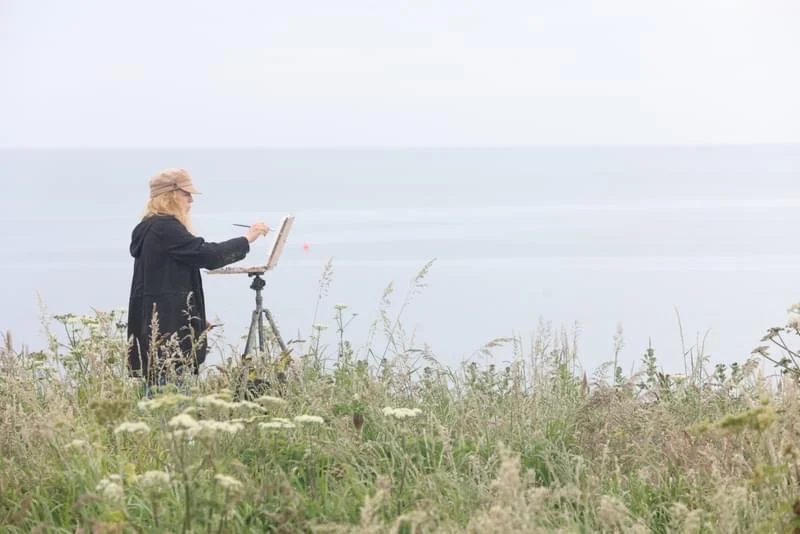Plein Air Oil Painting: A Beginner’s Essential How-To Guide

Painting outdoors, or en plein air, is one of the most rewarding ways to create art. It allows you to immerse yourself in nature, capture the atmosphere of a scene in real time, and develop a stronger sense of light, color, and composition.
In this guide, I’ll share what I’ve learned about plein air painting—from essential gear to practical tips—so you can get started with confidence.
What Is En Plein Air Painting?
Plein air painting simply means painting outside. While artists have done this for centuries, it’s most associated with the French Impressionists, who sought to capture the light and movement of the landscape in front of them.
Today, plein air painting remains popular, with festivals and groups dedicated to this practice worldwide.
Why Paint Outdoors?
I paint outside because it’s a wonderful way to spend the day. It’s both challenging and rewarding, and it has helped me:
- Loosen up my brushstrokes and speed up my process
- See color and value relationships more accurately than in a photo
- Capture the spontaneity of a scene that a studio setting can’t replicate
- Connect with my environment and observe how it changes over time
Another major benefit is the plein air painting community—one of the most welcoming and encouraging groups of artists I’ve met. Whether at festivals or casual meetups, painting alongside others makes the experience even more enjoyable.
Essential Plein Air Painting Gear
One of the first challenges beginners face (myself included!) is deciding what to bring. You want to be prepared but also keep your setup lightweight and efficient. Here’s what I use:
1. Pochade Box
A pochade box serves as your easel and palette in one. I use the U.Go Plein Air Pochade Box in both medium and large sizes, but there are many options, including DIY solutions.
2. Tripod & Stabilization
- A sturdy but lightweight tripod is essential. I use the Manfrotto BeFree.
- A tripod sandbag (I use one similar to this) helps weigh it down in the wind and doubles as a storage spot for my paper towels.
3. Brushes & Palette Knife
- Flats & Filberts (sizes 4–10)
- A liner brush for details
- A palette knife for mixing and texture
4. Painting Surfaces (Panels & Canvas)
Plein air painters usually prefer panels because they’re durable and easy to transport. I use:
- Canvas boards- economical f quick studies, I give them an extra layer of gesso before using them
- Ampersand Gessobord for a smooth surface, expensive but really nice to work on
- Canvas pads, which I tape to a board and later mount if I like the painting
5. Paints
I squeeze my paint out before I leave and cover it with cling film. My core colors include:
- Titanium White & Titanium Extra Pale (Williamsburg)
- Ultramarine Blue, Burnt Sienna, Winsor Red, Winsor Yellow, Winsor Lemon, Green Gold (Winsor & Newton)
- Payne’s Grey & Violet (Rembrandt)
- Radiant Turquoise & Radiant Violet (Gamblin)
- Yellow Ochre Deep (Michael Harding)
How to Paint Quickly Outdoors
- Use a viewfinder to compose your scene and mark a grid on your panel.
- Start with a notan sketch (black-and-white value study) to plan your composition.
- Block in large shapes first using Burnt Umber or a local color.
- Refine details last, focusing on edges, highlights, and focal points.
How to Improve at Plein Air Painting Quickly
1. Give Yourself 30 Paintings Before Judging Your Work
When I started, I decided I wouldn’t evaluate my paintings until I had painted outdoors 30 times. This gave me time to:
- Get comfortable with my tools.
- Adapt to changing light and weather.
- Stop panicking when people stopped to watch!
2. Join a Plein Air Group or Festival
Painting alongside others removes the awkwardness of being outside alone and lets you learn from fellow artists. It’s also reassuring to see that even experienced painters have “off” days.
Conclusion
Plein air painting is challenging, but it’s absolutely worth it. It teaches you to:
- Observe values and colors more accurately
- Loosen up your technique
- Capture a sense of place and atmosphere that a photo never can
It’s also a fantastic way to spend time outdoors, meet fellow artists, and create something truly unique to the moment.
If you’re new to plein air painting, just start! Embrace the process, and don’t worry about perfection.